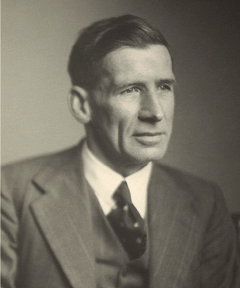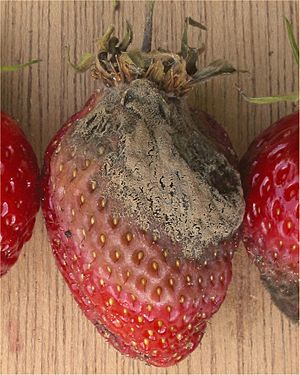William Brown (plant pathologist) facts for kids
Quick facts for kids
William Brown
|
|
|---|---|
| Born | 17 February 1888 Middlebie |
| Died | 1975, 18 January 1975 |
| Alma mater | |
| Occupation | Mycologist, phytopathologist |
| Employer | |
William Brown (1888–1975) was a British scientist who studied fungi (mycology) and plant diseases (plant pathology). He is famous for his important research on how fungi grow and how they cause diseases in plants. This work took place between 1912 and 1928.
Brown was born in rural Scotland and studied at the University of Edinburgh. He spent most of his career at the Imperial College of Science and Technology in London. There, he started a special research group for plant pathology in the 1920s. In 1928, he became Britain's first professor of plant pathology. He also led the botany department from 1938 to 1953. William Brown was also the president of important scientific groups like the Association of Applied Biologists and the British Mycological Society. He studied fungi like Botrytis cinerea, which causes grey mould, and Fusarium species that harm apples.
Contents
Early Life and Education
William Brown was born in 1888 in Middlebie, a village near Annan in Scotland. His mother was Margaret Brown, and his father, Gavin Brown, fixed farm mills and later owned a small farm. William had an older brother.
His family moved when he was young, and he went to school in Cummertrees village and then Annan Academy. He also helped out on the family farm. In 1904, he started studying at the University of Edinburgh. He earned a degree in mathematics in 1908. He also studied physics, chemistry, geology, and botany. In 1910, he received another degree in subjects like petrology (the study of rocks) and plant physiology (how plants work). He won many awards for his excellent work.
Career and Research
From 1910 to 1912, William Brown taught plant physiology at the University of Edinburgh. In 1912, he moved to London to do research at Imperial College of Science and Technology. He worked under a scientist named Vernon H. Blackman. In 1916, he earned a DSc degree from the University of London.
Brown became a research assistant and later a research physiologist at Imperial College. In 1928, he became a professor of plant pathology. This was the first time someone held this title in Britain! From 1938 to 1953, he was the head of the botany department. He retired in 1953 but continued to work as an editor for a science journal until 1969.
Understanding Plant Diseases
William Brown's most important research happened between 1912 and 1928. He studied how fungi cause diseases in plants. He focused on Botrytis cinerea, which causes a soft rot called grey mould in many plants. He often used lettuce and broad beans for his studies.
Scientists before him knew that fungi damaged plants by breaking down their cell walls and killing their living parts (protoplasts). Brown discovered that fungi produce special chemicals called pectinase enzymes. These enzymes, found at the tips of fungal threads (hyphae), cause both effects.
He also studied how fungal spores infect plants. He found that nutrients from a plant's leaf or petal can pass through its outer layer (cuticle). These nutrients help the fungal spore grow and infect the plant. He also learned that pollen grains release nutrients that can help fungi infect plants.
With his colleague C. C. Harvey, Brown looked closely at how fungi break through the plant's protective cuticle. They found that a special needle-like hypha simply pushes through the cuticle. It does this by growing with force, not by using enzymes. They also showed that if the plant tissue underneath is weak or "flaccid," it's harder for the plant to stop the fungus from getting in.
Fungal Growth and Apple Diseases
In the 1920s, Brown also studied how fungi grow in the lab. He experimented with different types of mould that spoil apples. He looked at how factors like oxygen, carbon dioxide, and temperature affected fungal growth and spore germination.
He discovered that high levels of carbon dioxide and low temperatures both slow down fungal growth. But the best results came from using both methods together. His findings were very useful for improving how fruit is stored. He also showed that things that stop fungal growth work best when the fungus's "energy of growth" is low. This idea is important for understanding how fungi behave in nature.
From 1924 to 1928, Brown did detailed studies on several Fusarium species that attack apples. This research also helped scientists better classify the Fusarium group of fungi in 1941.
In the 1930s, Brown started studying plant diseases in fields, especially those affecting vegetables like lettuce, potatoes, and carnations. During World War II, he researched important crop plants. He also gave talks and wrote about the history of microbiology and mycology in the 1950s and 1960s.
Awards and Recognition
William Brown was chosen as a fellow of the Royal Society in 1938, which is a very high honor for a scientist. He also served on the society's council. He was president of the Association of Applied Biologists and the British Mycological Society. He was also made an honorary member of the British Mycological Society in 1963.
Personal Life
In 1921, William Brown married Lucy Doris Allen. She was also a scientist, studying botany, biochemistry, and chemistry. They had three daughters and one son. Their oldest daughter, Lucy M. Brown, became a professor at the London School of Economics.
The family lived in different places around London before moving to Haddenham when William retired. He enjoyed gardening and reading old Latin and Greek books. After his wife passed away, William lived with his daughters. He died in 1975 in Stalybridge, Greater Manchester.
Selected Publications
- William Brown (1965). "Toxins and cell-wall dissolving enzymes in relation to plant disease", Annual Review of Phytopathology 3: 1–21.
- William Brown (1922). "On the germination and growth of fungi at various temperatures and in various concentrations of oxygen and of carbon dioxide", Annals of Botany 36: 257–283.



